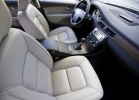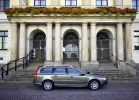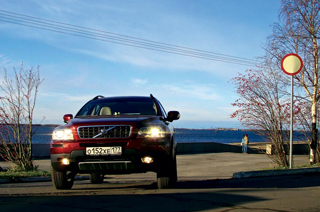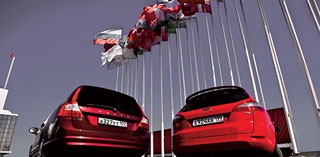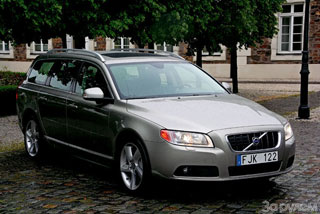Wilvo V70 test drive since 2007
Alternative
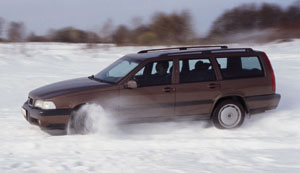 In the report from the Detroit car dealership (Motor E 3, 1999), the birth of a new category of cars - hybrids combining the features of sedans, station wagons and SUVs was noted. The last addition in this category is BMW X5. This car had ideological predecessors - to take, for example, Matra/Simca Rancho at the end of the 70s. Or the later Golf Country, Audi Allroad Quattro, Subaru Forester, Subaru Legacy Outback (it seems, she did not build other Subaru machines). The VOLVO V70 XC (Cross Country) off -road station wagon, first shown to the public in the fall of 1997, is one of them ...
In the report from the Detroit car dealership (Motor E 3, 1999), the birth of a new category of cars - hybrids combining the features of sedans, station wagons and SUVs was noted. The last addition in this category is BMW X5. This car had ideological predecessors - to take, for example, Matra/Simca Rancho at the end of the 70s. Or the later Golf Country, Audi Allroad Quattro, Subaru Forester, Subaru Legacy Outback (it seems, she did not build other Subaru machines). The VOLVO V70 XC (Cross Country) off -road station wagon, first shown to the public in the fall of 1997, is one of them ... The off -resistance of the V70 XC does not catch the eye - an ordinary family station wagon, which externally differs from the Volvo V70 AWD, which we met two years ago (Motor E 2, 1997). Only with a more careful study, you notice that the shape of the bumper is different, the roof rails are more massive, the pattern of the radiator grille became different.
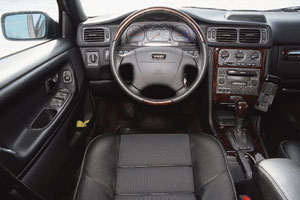 The salon seems to be unchanged. Everything is in place: full electric package (glass, mirrors, seats, hatch), steering column adjustable in length and height, leather-directed trim, stereomagnetic with a CD player and the ability to connect a CD changer, heating chairs, cruise control, automatic climatic Installation and an on -board computer, which display a mass of information on the display - is necessary and not very ... However, holding nets in the luggage compartment appeared, as well as an apron leaning to the rear bumper - protecting the knees from dirt during loading. Well, and exclusive rugs ... And that’s all?
The salon seems to be unchanged. Everything is in place: full electric package (glass, mirrors, seats, hatch), steering column adjustable in length and height, leather-directed trim, stereomagnetic with a CD player and the ability to connect a CD changer, heating chairs, cruise control, automatic climatic Installation and an on -board computer, which display a mass of information on the display - is necessary and not very ... However, holding nets in the luggage compartment appeared, as well as an apron leaning to the rear bumper - protecting the knees from dirt during loading. Well, and exclusive rugs ... And that’s all? 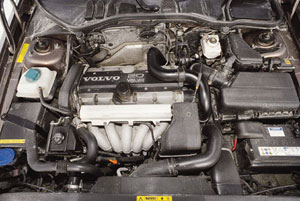 The motor is the same (2 liters of volume, 5 -cylinder, with turbocharged, with a capacity of 225 hp), is located transversely. The transmission is automatic, includes an interdosseous viscous coupling and a self -locking rear differential. So what's the difference?
The motor is the same (2 liters of volume, 5 -cylinder, with turbocharged, with a capacity of 225 hp), is located transversely. The transmission is automatic, includes an interdosseous viscous coupling and a self -locking rear differential. So what's the difference? 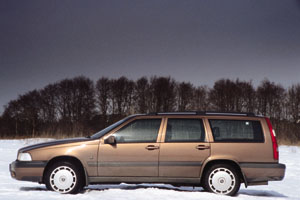 We look at the technical data. The only differences that were found was an increased road clearance, an extended 10 mm wheelbase and slightly changed dimensions (length increased due to bumpers, height due to clearance). Maybe some features will appear on the go?
We look at the technical data. The only differences that were found was an increased road clearance, an extended 10 mm wheelbase and slightly changed dimensions (length increased due to bumpers, height due to clearance). Maybe some features will appear on the go? On dry asphalt, the dynamics of the V70 XC gives an impression on most cross -country neighbors. The machine behaves like an ordinary front -wheel drive car. Only 5% of the engine power is transmitted to the rear bridge in normal mode. In the case of slipping of any pair of wheels - front, rear, left, right - the force is redistributed to the pair that has the best adhesion to the road. Electronics, viscous coupling and ABS perform it almost instantly. (Twisting the moment in the back increases and with an increase in the load on it, for example, while moving with a trailer.)
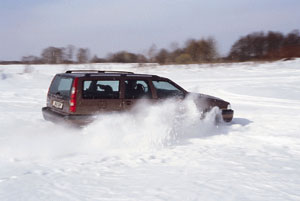 Even more pleasant that the behavior of the car does not change on the ice coating. The laws of physics seem to remain out of work. The electronic system Tracs at speeds up to 40 km/h regulates the thrust on the front wheels, preventing their slipping during acceleration. Provocation on sliding with swinging into the half of the brake pedal remains unanswered due to good operation of ABS. Again acceleration and sharp braking, but now I'm trying to maneuver, go with a snake. The car holds the trajectory perfectly! Attempts to disrupt the car into an uncontrolled skid led to nothing. Electronics and viscous coupling manage to track and correct the driver’s mistakes.
Even more pleasant that the behavior of the car does not change on the ice coating. The laws of physics seem to remain out of work. The electronic system Tracs at speeds up to 40 km/h regulates the thrust on the front wheels, preventing their slipping during acceleration. Provocation on sliding with swinging into the half of the brake pedal remains unanswered due to good operation of ABS. Again acceleration and sharp braking, but now I'm trying to maneuver, go with a snake. The car holds the trajectory perfectly! Attempts to disrupt the car into an uncontrolled skid led to nothing. Electronics and viscous coupling manage to track and correct the driver’s mistakes. 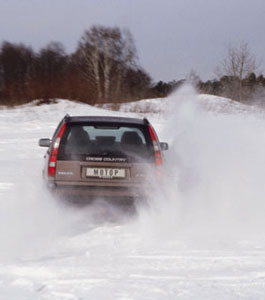 Complicating the task. A platform covered with loose snow, in which Volvo burns out periodically. The underground work of the mechanics is felt - one wheel or the other, the machine, as it were, is looking for a way out of this situation. This happens very quickly, and in the end the car copes with the task - it leaves such a position that at least the tractor go.
Complicating the task. A platform covered with loose snow, in which Volvo burns out periodically. The underground work of the mechanics is felt - one wheel or the other, the machine, as it were, is looking for a way out of this situation. This happens very quickly, and in the end the car copes with the task - it leaves such a position that at least the tractor go. I let the car in a circle, gradually accelerating - finally the front end begins to take out. The car does not respond to the steering wheel and add gas. But the discharge of gas immediately causes a dive inside ...
The behavior of the machine in different modes seemed quite logical and predictable (unlike, for example, all -wheel drive Audi, having a very similar transmission, but with a rather obstinate zero). But any differences in the manners of the V70 AWD and V70 XC could not be found.
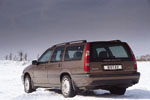 So why was the version of the XC? It seems that this is nothing more than a marketing move, an attempt to give the car a different image. It is worth recalling that the main market for Volvo is American (approximately 25% of sales), which requires primarily SUVs, but there are no company in the range.
So why was the version of the XC? It seems that this is nothing more than a marketing move, an attempt to give the car a different image. It is worth recalling that the main market for Volvo is American (approximately 25% of sales), which requires primarily SUVs, but there are no company in the range. 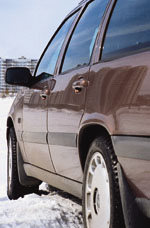 So they tried to give out a pig for crucian carp, offering a sports station wagon with off-road capabilities as a more civilized and comfortable alternative (something similar is trying to make Saab with its Universal 9-5).
So they tried to give out a pig for crucian carp, offering a sports station wagon with off-road capabilities as a more civilized and comfortable alternative (something similar is trying to make Saab with its Universal 9-5). However, this does not detract from the virtues of the V70 XC (and V70 AWD). An excellent car - both for the city and for the highway. He will not bring either a snowy and icy highway either in a rash or a not very prepared driver.
Alexey Strelkov
Source: Motor magazine [No. 4/1999]
VOLVO V70 Crash Video since 2007
VOLVO V70 test drive since 2007
VOLVO V70 Crash Test since 2007
Krassh Test: Detailed Information34%
Driver and passengers
16%
Pedestrians
41%
Children-passengers


